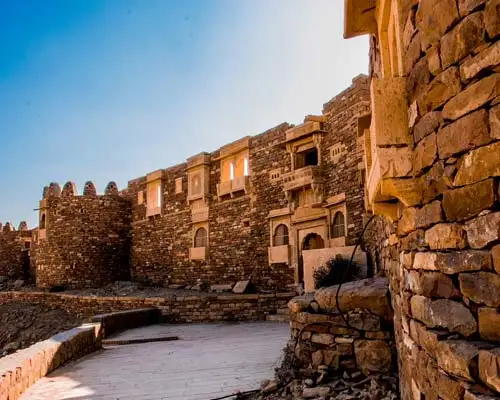Khaba Fort (Information)
| Location | Jaisalmer |
| Timings | 9:00 AM - 6:00 PM |
| Entry Fee | 50 per person for Indians 100 per person for Foreign Nationals |
| Time Required | Approximately 1-2 hours |
| Best Time to Visit | From November to March |
Khaba Fort in Jaisalmer is ruined citadel situated amidst the scorching heat of the Thar Desert. The history of this barren, eerie, and mystic village, dates back to the 13th century. The architecture once belonged to the Paliwal Brahmins of the Kuldhara village who fled the town in the 19th century leaving behind a ghost town. The stairs at the fort entrance lead to the focal point of the entire village and the surrounding countryside. You can also walk through the ramparts and the quiet streets of the fort to the mystical Kuldhara village that stretches from the base of the fort for a spooky experience.
The turreted towers, intricate latticeworks, and the beautiful windows add elegance to the structure. Its charm is enhanced by a muster of peacocks. It also houses a small museum with ancient artifacts and various kinds of rock fossils. The Shiva temple, mud huts are the other remnants of the place. The staircases that lead to the underground is home to 80 deserted sandstone abodes. Here is something uncanny- before anyone leaves the fort, its former residents cast a spell to prevent anyone from settling in the village ever again. Till date, the fort is nothing but ruins of what was left behind 200 years ago.
History of Khaba Fort Jaisalmer
Khaba Fort Jaisalmer was built in the 14th century by the Paliwal Brahmins, who were known for their wealth and prosperity. Invaders were defended from the fort by its defensive structure. The Paliwals were known for their self-sufficient lifestyle, and the fort was also designed to be self-sufficient.
The fort was built with a complex water management system that allowed the Paliwals to store and conserve water for long periods of time. The fort was abandoned in the 19th century due to a severe drought, and today it stands as a testament to the ingenuity and resilience of the Paliwal Brahmins.
Structure of the Khaba Fort
The village was based around an ancient temple surrounded by a cluster of houses. All of these houses strangely enough, do not have a roof. The entire space is deserted, crumpled and in a dilapidated state giving it a look of an eerie horror site. There are ramparts and broken fortifications and lately an effort has been made for the restoration of the same. It is believed that the traders coming from the Silk Route stayed at the fort for the night and had to pay taxes, after which they were allowed inside the city.
How to Reach Khaba Fort Jaisalmer
Khaba Fort Jaisalmer is located approximately 20 km from the city of Jaisalmer. The fort can be reached by various means of transportation.
Via Air: The nearest airport to Khaba Fort Jaisalmer is Jaisalmer Airport, which is located approximately 40 km from the fort. Visitors can opt for cab rentals in Jaisalmer from the airport to reach the fort.
Via Train: Khaba Fort Jaisalmer is approximately 20 kilometers from Jaisalmer Railway Station. Getting to the fort is possible via taxi or rental car from the railway station.
Via Road: Khaba Fort Jaisalmer is well-connected by road. For visitors to reach the fort, taxis and rental cars are available in Jaisalmer City. The fort is located approximately 20 km from the city.
Jaisalmer Tourism
When planning for Jaisalmer, you must decide on the time when you would want to visit it. Jaisalmer Travel Guide & Tips!
People Also Ask Jaisalmer
-
What happened at Khaba Fort?
Khaba Fort is a cursed village of Paliwal Brahmins, who abandoned this place 200 years ago due to unknown reasons. The crumbling structure of the fort still has the ruins of the homes of some 80 families that used to live here.
-
Which fort is famous in Jaisalmer?
The city's most prominent landmark is the Jaisalmer Fort, also called Sonar Qila (Golden Fort). Unlike most other forts in India, Jaisalmer Fort is not just a tourist attraction.
-
Which stone is Jaisalmer famous for?
The yellow limestone and sandstone of Jaisalmer, famous as golden stone, have been extensively used in architectonic heritage of western India. The golden yellow limestone and sandstone built architectonic heritage impart an exquisite character to Jaisalmer city, which is popularly known as 'The Golden City'.
-
Which is the mysterious village in Jaisalmer?
Kuldhara is a ghost village about 17 kilometres west of Jaisalmer. Three centuries ago it was a prosperous town, but today it is an abandoned village shrouded in mystery.
 info@jaisalmertour.com
info@jaisalmertour.com












